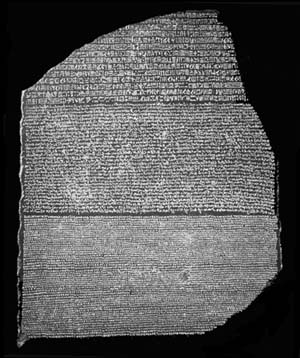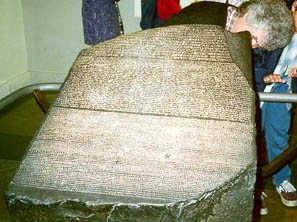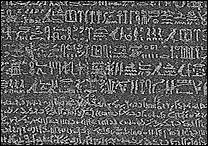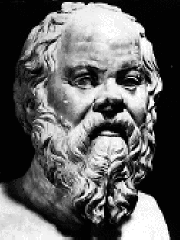
THE ROSETTA
STONE
In July 1799, a French officer of engineers unearthed a black, basalt slab of stone with Egyptian hieroglyphic, Greek letters, and a cursive Demonic Egyptian script inscribed on it. When it was discovered that the Greek text was the actual translation of the Egyptian hieroglyphics, the slab of stone became the master key to deciphering the ancient Egyptian hieroglyphs and the foundation to modern Egyptology.
The stone was named the Rosetta Stone because it was discovered near the city of Rashid (Rosetta) on the western delta of the Nile River. It has been dated to March 196 BC and its translation praises the Egyptian King Ptolemy V...
 The
Rosetta Stone changed everything. From the decipherment of this
single slab of stone, Egyptologists were now able to translate
the literary fragments of this magnificient civilization using
only the basic elements of the ancient hieroglyphic alphabet.
The
Rosetta Stone changed everything. From the decipherment of this
single slab of stone, Egyptologists were now able to translate
the literary fragments of this magnificient civilization using
only the basic elements of the ancient hieroglyphic alphabet.
But an alphabet is not a language, and the religions and philosophies of the ancient Egyptians hidden beneath the symbolic characters remain concealed. Literal translation of the text is not the difficult part; understanding the meanings beneath the words is. Remember this.
EGYPTIAN MAGIC, RELIGION & METAPHYSICS
The Egyptians held a great respect for God, the "gods," the Judgement, the Resurrection, and Immortality. They believed in the power of magical names, spells, enchantments, pictures, figures, amulets, and ceremonial magic.
Egyptian magic was an essential part of their religious philosophy. The priest-magicians of the old Egyptian Mysteries possessed an elaborate metaphysical doctrine. These well-educated scientific men understood the nature of the lodestone, mineral and animal magnetism, the art of reading the innermost secrets of the soul, sending their spirits from their body, clairvoyance, the virtues of magnets, herbs, drugs, and how to employ music for admirable effects.
The Egyptian priests acknowledged that the visible and invisible world (seen and unseen) together constitute Nature. The invisible world is as much a part of Nature as the visible.
The modern metaphysican does not believe in miracles, not did the Egyptian priests. There is a cause and effect for everything in Nature. People witness many effects, but if the causes elude their perception, they call these effects miracles. There are no such things as miracles. Learn that.
Modern science acknowledges cause and effect on the physical plane but not in the super-physical (moral, mental or psychological) field.
Consider these two sentances: "It is impossible to imagine the material world suspended from nothing, supported by nothing, and maintained by nothing. As surely as the physical life of man depends upon the presence of a subjective energy, so surely is the physical life of the universe supported by a life invisible and knowable only to the metaphysican." - Manly P. Hall
The ancient Egyptians were a highly civilized, highly informed and highly gifted people, trained in the mysteries of the invisible life. Not only did they develop their physical sciences (glass manufacturing, dentistry, engineering, refined music, chemistry, etc.) they also developed their metaphysical science to a magnificent philosophy of conscious immortality. Conscious immortality. These people had no fear of death.
 |
 |
 |
The modern world marvels at the genius of Plato, Aristotle and Socrates, yet reject the religious and philosophical doctrines of which they were the product. These learned men believed in metaphysics, magic, the gods (invisible divines beings) and they held profound discussions regarding the condition and state of the human soul. They established the highest form of learning the world had never known.
Now where do you think these great thinkers learned their philosophical and ethical principles?
Source:
Rosetta stone image, Microsoft Encarta Online Encyclopedia
2004
|
BACK |
LEARN |